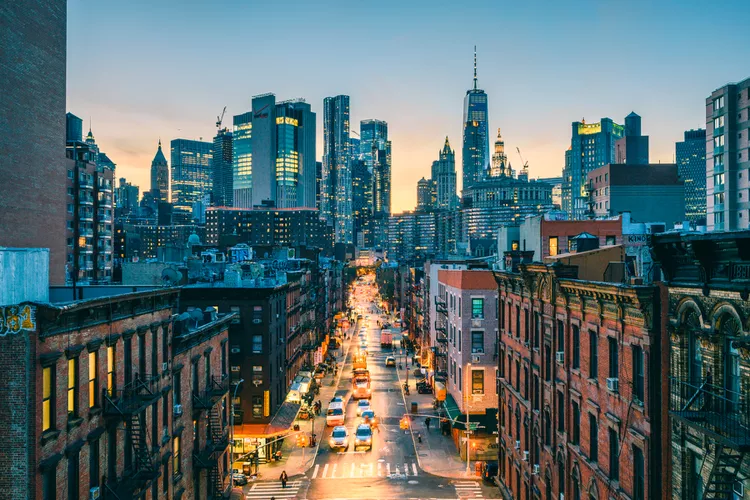
(Source)
Similar to the rest of the United States economy, the housing market experienced an enormous amount of inflation during the coronavirus pandemic. However, unlike the rest of the economy, the housing market has continued to have high inflation rates following the end of the pandemic. These high housing inflation rates pose serious problems for people, especially those who don’t make enough money to keep up with these increased prices. In New York City, the current median yearly salary is around $74,000, but the average rent for a 600 square foot apartment is almost $4,000 per month, or $48,000 per year. This difference between housing costs and income is a cause for concern because it indicates a lack of affordable housing. Ironically, New York City is one of the few areas in the entire country that actually has rent control laws in place. Rent control laws are government regulations that generally place a maximum on the amount that a landlord can charge people to rent or lease a residential property, and they also regulate how much rent can be increased per year for each unit of these properties. Although the specific details of rent control laws vary widely based on jurisdiction, they are generally put in place in order to keep housing affordable, especially for low-income residents. So, why does New York City still have astronomically high average rental prices even with rent control laws in place?
One possible answer to this question lies in the fact that New York City rent control laws are limited in certain ways. New York City has had the country’s longest-running rent control regulations which have been in place since 1943. The city has two main types of rent control laws: “rent control” and “rent stabilization.” Rent control covers tenants who have been living in the same apartment since 1971, and it works by imposing a “maximum base rent” which essentially only covers the landlord’s cost of maintaining the unit. In contrast, rent stabilization applies to buildings that are constructed before 1974 and have six or more units; these policies limits the amount of rent that can be increased annually. Furthermore, the Rent Guidelines Board of New York City is the entity that is responsible for deciding how much landlords are allowed to raise the rent every year for properties subject to rent stabilization.
One obvious limitation of New York City’s rent control laws is that they do not cover a lot of potential properties, so many residential buildings in the city can still have very high rental prices. As we can see from the rent regulation example above, New York City rent control laws only apply to people who have been living in the same unit continuously since 1971. This longevity requirement is extremely significant because people rarely live in the same apartment unit for that long, and landlords are allowed to convert these units into ones that are not covered by these types of laws after these tenants move out. Because of loopholes like this, rent controlled apartments in New York are so rare that they only cover about one percent of rental units. Similarly, rent stabilization laws in New York City are also limited in terms of applicability since they only apply to buildings that were constructed before 1974. Furthermore, there are also two possible reasons why rent stabilization might lead to increased rental prices. First, even if an apartment is rent stabilized, landlords are still allowed to raise rent by a certain percentage every year. This slight increase can add up over time and eventually lead to relatively higher rental prices down the road. Second, rent stabilization incentivizes landlords to raise the rent every single year in order to not lose out on potential profits. If the prices of these rental properties were governed by the market, rather than the Rent Guidelines Board, these landlords may not actually be able to raise the rent every year.
These aforementioned observations may lead you to believe that New York could solve its housing problems by simply amending their current rent control laws in order to cover more residential properties. However, the applicability limitations surrounding New York City’s rent control laws only partially explain why average rental prices in the city are still extremely high. New York City’s rent control laws obviously ensure affordability for current tenants, but they may actually also be decreasing affordability in the long run for a few reasons. First, because rent control laws intrude on the free-market system and force landlords to rent their properties below market value, they may be incentivized to completely take the unit out of the rental market which would decrease supply and therefore drive up the price for other units. Second, landlords may be disincentivized from creating new rental units since they might be subject to harsh rent control laws, further reducing supply. Finally, if landlords are making less money from their rent-controlled units, they might be incentivized to compensate for this loss by raising rents on their other non-rent controlled units. In this regard, if New York City wanted to truly combat their absurdly high housing costs, they should do more than just expand rent control coverage or make it more comprehensive; rent control needs to be supported by other initiatives such as affordable housing projects.
I think there is another reason why rent stabilization may actually increase rent prices: rent stabilization forces landlords to increase their rent every year, because if they do not increase their rent as allowed by the Rent Guidelines Board, they lose out on profits. Put differently, let’s assume that the Board allows for a five percent increase in rent per year. A landlord that does not increase his rent by five percent in a year permanently loses out on those profits, because the next year they can only increase rent by 5 percent and not 10. In the absence of the rent stabilization law, rent increases would theoretically be determined by the market, meaning that there may be some years where the landlord does not increase rent at all.
Suggested Citation: Brian Kam, Why is New York City Rent so High Even With Rent Control Laws in Place?, Cornell J.L. & Pub. Pol’y, The Issue Spotter, (Nov. 13, 2024), https://jlpp.org/why-is-new-york-city-rent-so-high-even-with-rent-control-laws-in-place/.


